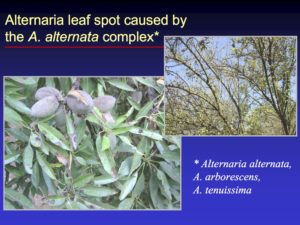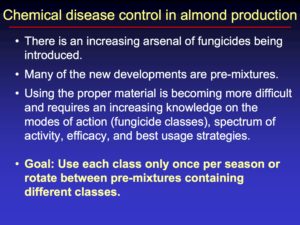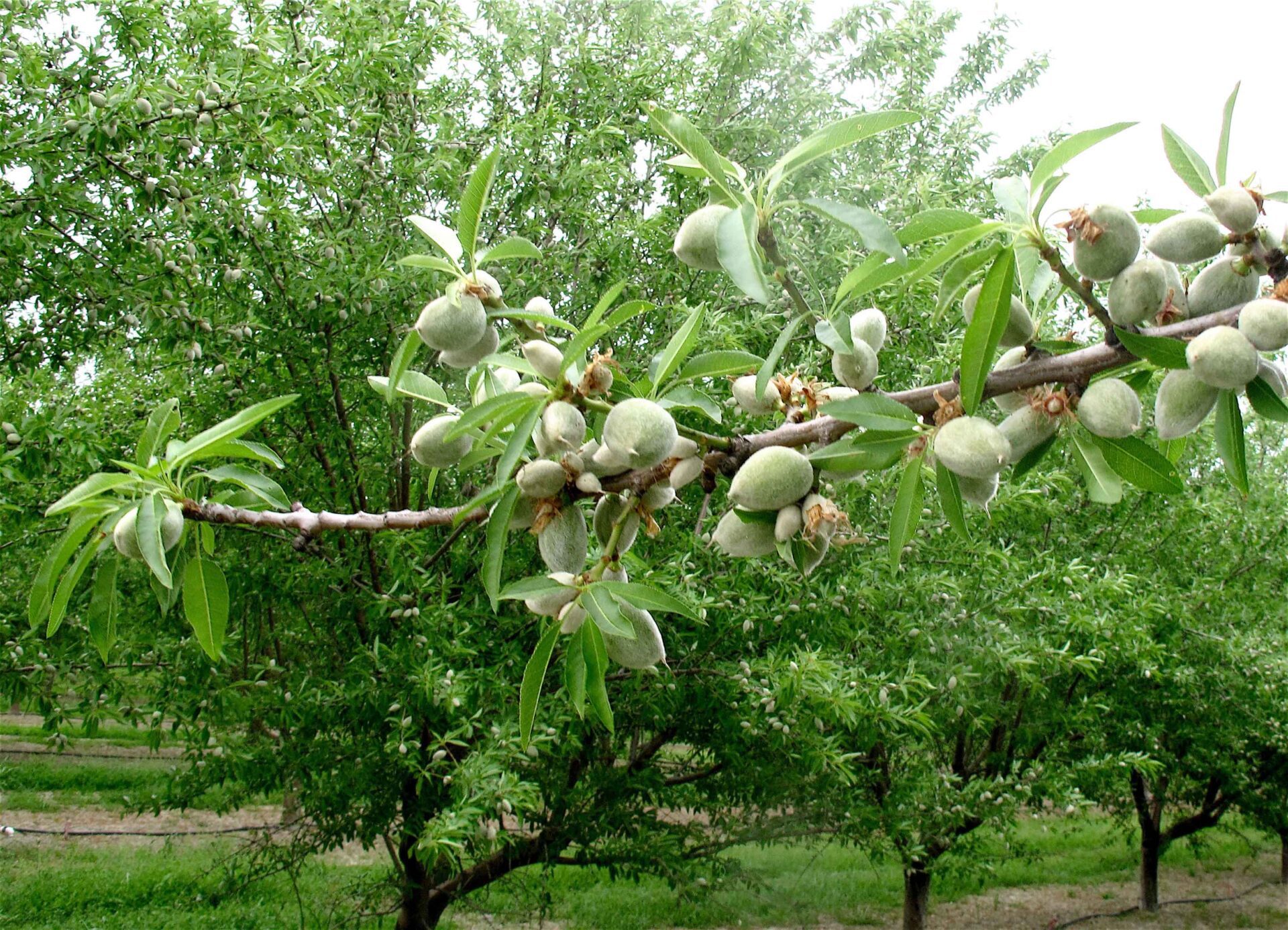From planting to maturity and crop production, almonds trees can be host to a plethora of diseases, be it bacterial, fungal, viral, parasitic or phytoplasmal.
These diseases and how to control them was the topic of Dr. Jim Adaskaveg’s presentation during this year’s North Valley Nut Conference hosted by West Coast Nut in conjunction with the UCCE Butte/Glenn Counties Almond and Walnut Day at Silver Dollar Fairgrounds in Chico.
Adaskaveg, professor and plant pathologist with the Department of Plant Pathology, UC Riverside, who specializes in foliar disease of almonds and other tree crops, shared the springtime diseases of almond that can be problematic in a wet spring season are blossom blight, jacket rot, anthracnose, shot hole and bacterial spot. Late spring-summertime diseases include scab, alternaria, leaf spot, anthracnose, rust and hull rot.
In an effort to control these and other almond diseases, Adaskaveg emphasized monitoring and risk assessment by determining pathogen population size, the possibility of disease outbreaks with weather forecasts, assess if, when and where disease management has to be implemented, and optimize disease management that is both effective and economical.
Another essential component in the fight against almond disease concerns optimum timing for implementing management practices, he said.
With inoculum-based disease, such as shot hole, scab, rust and bacterial spot, it is important to know the levels in the current and previous seasons as indicators for risk. This helps the grower to determine at what level the inoculum may or may not be present and disease progress can be monitored.
Once the inoculum is found, management practices can be implemented.
For host phenology-based diseases like blossom blight and Rhizopus hull rot, the disease occurs on specific host tissues during a limited time in the season and the inoculum is commonly present.
Diseases, such as alternaria, anthracnose and bacterial spot, which are microclimate based, again the pathogen inoculum is commonly present and climatic conditions determine disease progress.
“There are a number of fungicides and fungicidal formulations for managing almond diseases. Both inorganics and conventional synthetics,” Adaskaveg said.
Among the line of fungicides are new pre-mix formulations that combine two active ingredients having different modes of action against the target pathogen, he added, those include Inspire Super, Quadris Top, Quilt Xcel, Pristine, Luna Sensation, Merivon, Luna Experience and Viathon
“Fortunately, we are still getting lots of new products registered and part of our job is to keep on top of these new products, such as Kenja and Rhyme which are new products registered this past year for almonds,” Adaskaveg said. “In addition, there are other new products coming out on the market which is very good for the industry and provides growers with a lot of good choices.”
He reminded growers of the necessity to be out in the field looking, knowing, monitoring and scouting to learn and recognize “what is out there” and what type of problems they might be faced with in their orchards.
“It is important to know what is taking place concerning pathogens as they have to build up from year to year. If you find a problem late in the fall you can be pretty well guaranteed to have that problem in the spring,” Adaskaveg added. “When the weather turns wet and we know what is going on in our orchards, growers can be better prepared and knowledgable on how to apply our disease management programs.”
He said some of the determining factors for timing of bloom applications concerns environmental conditions such as rainfall and temperature.
When environmental conditions are less favorable to disease and fungicide properties have locally systemic action, a single spray at 30-40 percent bloom is acceptable.
However, Adaskaveg recommended when conditions are favorable to disease, rain forecast and warm temperatures, fungicide properties should be protective or locally systemic action and two sprays applied, at 5 percent bloom and at 80 percent bloom.
During a presentation at a conference in Monterey, Adaskaveg noted that fungal organisms are quite dynamic and can develop resistance to fungicides rapidly, and called for an effort by both growers and the ag chemical industry to keep their “guard up” for pitfalls in introduction of new materials and methods, as strategies are developed for future use of them.
He emphasized the objective is to minimize pathogen survival by avoiding repeated exposures to the same class of fungicides to pathogens, especially in areas of high disease populations.
There are already several reported cases of disease resistance to fungicides in almonds and Adaskaveg said growers need to be aware of these instances and educate themselves on alternative applications and the need to rotate uses.
Brown rot and green fruit rot
For brown rot fungus infection during the 7 to 14 day bloom, Adaskaveg said any type of wet weather, be it rain or fog, are important factors.
Adaskaveg recommends spraying a fungicide once at pink bud, at least once at full bloom or two weeks after the first spray, and, depending on the weather, once at petal fall.
It is the same for green fruit rot with the elimination of applications at pink bud.
“Timing is based on host phenology, environmental conditions, and acreage to treat,” he said. “Again, we have a lot of new fungicide products on the market and soon to be registered and released that give growers a large margin to choose from.”
Blossom blight and gray mold
Adaskaveg said blossom blight is actually a canker fungus that goes down through the spurs and gets into the branch of the almond tree and forms a canker that can last for several years.
“So prevention from getting brown rot blossom blight from ever starting is critical if you don’t want subsequent years problems,” he said. “Once it is in there it is hard to control, although it will eventually die out.”
He shared a number of fungicides on the market for treatment of both these diseases, such as Approach and Quadris Top.
Adaskaveg said research has found applying fungicide at full bloom and petal fall is recommended, however, if the weather is wet an application at pink flower is also recommended.
Bacterial spot
According to Adaskaveg, bacterial spot is a fairly new disease in California, first diagnosed in the spring of 2013 and is caused by the bacteria Xanthomonas arboricola pv. pruni.
The almond variety Fritz appears to be the most susceptible to bacterial spot at this time.
Bacterial spot occurs on the tree’s leaves, twigs, and with the most obvious symptoms on the fruit. Typically, almond hull lesions start as small, watery blemishes that produce light to dark amber gumming. The amber color of the gumming is important as it helps distinguish bacterial spot from the clear gum of leaffooted bug feeding injury. The infection can reach the kernel and cause off grades or unmarketable fruit.
The pathogen overwinters in fruit mummies on the tree.
“So the winter shakes to get rid of those mummies for other pests and diseases is also helping to protect against bacterial spot,” he added.
The most effective management program for bacterial spot is a delayed dormant application to reduce inoculum and at least one or two in-season applications around rainfall events and rising temperatures to prevent new infections.
Adaskaveg recommends the use of copper at full bloom and petal fall, twice in the spring and in the summer, as well as application of mancozeb at petal fall and in the spring.
“That program should work well for management of bacterial spot,” he said.

Late spring, summer diseases
Anthracnose can cause a lot of problems with a lot of rainfall, Adaskaveg explained, and that is something growers need to be aware of, especially this year.
Almond scab, hull rot and alternaria were other spring and summer bacterial problems he discussed.
Adaskaveg said almond scab has become a common disease at many locations in recent years and needs to be managed.
Effective management requires knowledge of the disease history of the orchard, application of dormant treatments to delay twig sporulation, monitoring for twig sporulation in the spring and fungicide application at petal fall and at the beginning of twig sporulation.

Adaskaveg warned that almond scab has some fungicide resistance and not to apply single-site mode of action fungicides once the disease is developing.
“Plan for rotation programs and integrated strategies,” he added.
There are a number of almond varieties reported to be highly susceptible to scab – Carmel, Merced, NePlus Ultra, Peerless, Price, Ruby, Sonora and Winters. Less susceptible is Butte, Fritz, Mission, Monterey, Wood, Colony and Thompson, with Nonpareil being the least susceptible.
The majority of these late season diseases cause damage to leaves which then fall off the trees prematurely.
“And this is not good for the tree,” Adaskaveg said.
He recommended in an effort to manage scab and other diseases, growers practice planting design that allows for air circulation, tree pruning that increases air movement and reduces relative humidity, irrigation management that reduces relative humidity, clean cultivation, and avoidance of heavy late-summer/fall fertilization with nitrogen to reduce production of highly susceptible host tissues.
He cautioned growers that “if your neighbor is battling a particular disease, you can pretty well count on that disease moving into your orchard, so be prepared.











